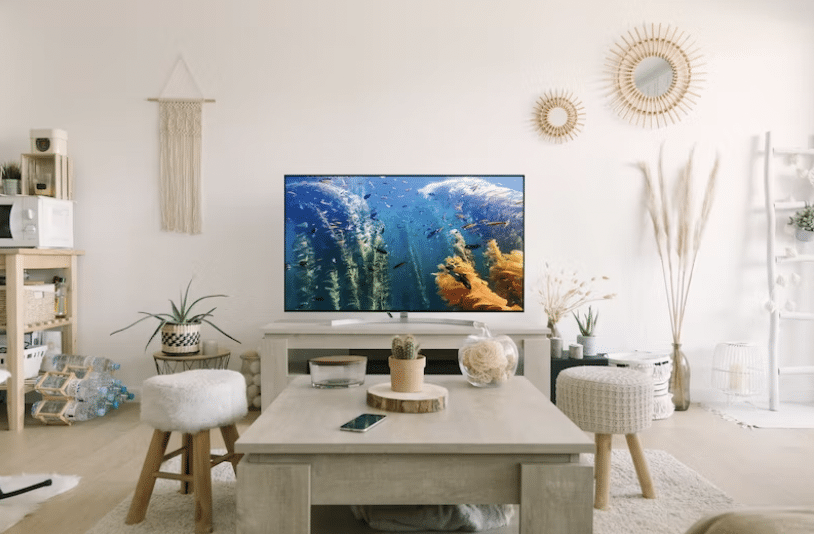November 15, 2023
Behind the Screen: What’s the True Price of TV Commercials

When it comes to television advertising, the glittering final product is often the only aspect that viewers see. But behind every polished TV commercial lies a web of strategic planning, creative development, and meticulous production.
One of the first questions that businesses looking to break into TV advertising ask is, “How much does a TV commercial cost?”
In this blog post, we’ll show you what makes up the cost of TV ads and provide you with insights on budgeting for your next ad.
Factors Influencing TV Commercial Costs
Before diving into the numbers, it’s essential to understand the two key factors that influence the cost of TV commercials: media and creative.
Below, we’ll unpack these variables to provide a clearer picture of what goes into the budgeting for your TV spot.
Media Buy
- Network Reach: National networks like NBC and CBS command higher prices due to their extensive reach, while local stations offer more budget-friendly options.
- Time Slot: Prime time slots cost a premium, whereas off-peak hours can be more economical.
- Seasonality: Advertising during high-viewership periods like holidays or sports seasons can affect costs.
- Frequency: The number of times your ad runs also impacts the overall media buying expense.
Creative
- Talent and Crew: A-list actors or a large crew size generally increase production costs.
- Production Elements: Special effects and custom set builds contribute to the cost of creating a TV ad.
- Post-Production: Editing, color correction, and sound design require specialized skills and time, influencing the final cost.
- Deliverables: More versions of the ad (e.g., different lengths or tailored for various markets) require additional resources.
Types of TV Commercials
TV advertising offers a wide range of options for commercials. The type chosen affects the creative direction and costs. Let’s delve into the various styles that can bring a brand’s message to life on the screen.
Animated Ads
Animated ads encompass a spectrum from basic 2D graphics to realistic 3D environments. They provide a flexible and often cheaper way to tell a brand’s story.

Live-Action Ads
Live-action ads, featuring actual individuals and locations, establish a strong emotional bond. The cost of making them varies based on how complicated the shoot is–that is, the number of shoot days and production spend like locations, talent, music, propping/styling, and more.
Footage Rework Advertisements
Creatively reimagining existing footage gives it a new lease on life. Budget-friendly and quick-to-market, footage rework ads allow brands to stay relevant and responsive with a fresh twist on their message.
.
Learn more about crafting compelling TV commercials with Quirk
Anatomy of TV Ad Production Costs
Understanding the cost breakdown of a TV commercial is crucial for any brand considering dipping their toe into the medium.
Scriptwriting and Storyboarding
The foundation of any commercial lies in its concept, script and storyboards, which guide the production through to completion. The number of deliverables, such as different versions for various markets or lengths for A/B testing, can affect the complexity and cost of this stage. A well-crafted script and detailed storyboard are investments that ensure the commercial effectively communicates the brand’s message.
Casting and Talent Fees
Casting the right talent is pivotal, whether it’s a recognizable celebrity, a non-union actor, or a social media influencer. Each brings their own set of fees and can impact the commercial’s reach and effectiveness.
Celebrity endorsements can command high prices but may offer unmatched exposure, while influencers might provide a more cost-effective way to reach specific demographics.
Filming and Editing
The filming process itself, along with post-production editing, is where the vision comes to life. During this phase, you need to budget for equipment, location fees, and technical crew. You also need to consider time-consuming tasks such as editing, color correction, and adding special effects or animations.
The level of sophistication in filming and editing will be reflected in the commercial’s final cost and overall impact.
Budget Split
When it comes to TV commercials, it’s important to know how much money goes to buying ads and making them.
This balance is key to maximizing the impact of your ad spend and making sure that the creative quality matches the media investment.
Industry standards generally recommend spending 20-30% of the media budget on creative production. This ensures that the content quality is high enough to engage viewers and make the media buy worthwhile.
The creative aspect is important in budgeting. Skimping on creativity or production quality can lead to poor outcomes. Even expensive media placements can be ineffective if the commercial doesn’t resonate with the audience.
Return on Investment (ROI) Analysis
Understanding the Return on Investment (ROI) for TV commercials is crucial. This evaluation measures how the advertisement enhances brand value and achieves marketing objectives.
Effective measurement looks at more than just the immediate financial return. It also considers the commercial’s impact on brand awareness, customer engagement, and sales, which are integral to the campaign’s overall success and guide future marketing strategies.
While digital advertising offers a clear-cut path to measuring ROI through clicks, impressions, and conversions, assessing the ROI for Linear TV commercials presents a more complex challenge.
For example, with digital ads, data is instantly available and measurable. To understand the performance of TV ads, you’ll need to rely on indirect indicators such as increased website traffic, sales spikes following air times, or surges in search volume for the brand.
This indirectness necessitates a nuanced approach to evaluating a TV commercial’s effectiveness, one that looks beyond direct sales metrics to understand its true impact on the brand’s growth and market position.
This complexity makes it essential to consider a range of factors, such as those outlined below, to fully grasp the ROI of TV commercials.
Factors Influencing ROI
- Target Audience Alignment: The commercial’s ability to reach and resonate with the intended demographic.
- Creative Impact: The quality and memorability of the ad’s creative elements.
- Media Placement Precision: How well the ad’s placement aligns with optimal viewing times and networks for the target audience.
- Call to Action Strength: The clarity and persuasiveness of the call to action within the ad.
- Market Conditions: Current trends and consumer behaviors that may affect the ad’s reception.
- Competitive Landscape: The standing of the ad against competitors’ efforts and market saturation
In Sum
Crafting an effective TV commercial is a delicate balance of art and economics. It’s about understanding the nuanced dance between the cost of production and the value of creative expression.
From the media buying intricacies to the creative decisions that shape a brand’s story, every choice carries weight in the financial blueprint of a commercial.
The journey from concept to screen is paved with strategic decisions that can elevate a brand, resonate with viewers, and ultimately, define the success of the campaign. It’s this careful orchestration of budget and creativity that turns a simple message into a powerful broadcast narrative.
Navigating the complexities of TV commercial production is our specialty at Quirk Creative. We blend creative vision with budgetary acumen to deliver content that captivates and converts.
If you’re wondering ‘how much does a TV commercial cost?’ and are looking to bring your brand’s story to life on screen, we’re here to help. Get in touch for a consultation on your next TV commercial project.
..
